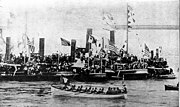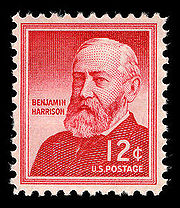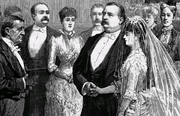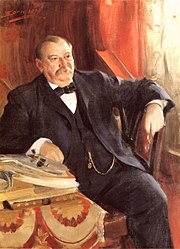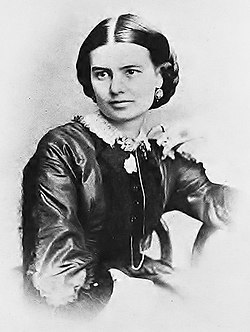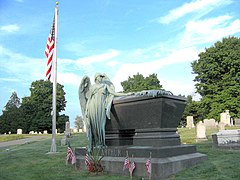
Benjamin Harrison (August 20, 1833 – March 13, 1901) was the twenty-third President of the United States, serving one term from 1889 to 1893. He had previously served as a senator from Indiana. His administration is best known for a series of legislation including the McKinley Tariff and federal spending that reached one billion dollars. Democrats attacked the "Billion Dollar Congress" and defeated the GOP in the 1890 mid-term elections, as well as defeating Harrison's bid for reelection in 1892. He is to date the only president from Indiana.
Early life and Civil War
A grandson of President William Henry Harrison and great-grandson of Benjamin Harrison, V, Benjamin was born on August 20, 1833, in North Bend, Hamilton County, Ohio as the second of eight children of John Scott Harrison (later a U.S. Congressman from Ohio) and Elizabeth Ramsey Irwin. He attended Miami University, Oxford, Ohio, where he was a member of the fraternity Phi Delta Theta (later in life, he joined Delta Chi) and graduated in 1852. He studied law in Cincinnati, Ohio, then moved to Indianapolis, Indiana in 1854. He was admitted to the bar and became reporter of the decisions of the Indiana Supreme Court.
On October 20, 1853, Harrison, 20, married Caroline Lavinia Scott, 21, in Oxford, Ohio. The wedding was performed by her father, Rev. John W. Scott. The Harrisons had two children, Russell Benjamin Harrison (August 12, 1854 - December 13, 1936) and Mary "Mamie" Scott Harrison McKee (April 3, 1858 - October 28, 1930). On June 13, 1861, they suffered the tragedy of a miscarriage.
Harrison served in the Union Army during the Civil War and was appointed Colonel of the 70th Indiana Volunteer Infantry Regiment in August 1862. The unit performed reconnaissance duty and guarded railroads in Kentucky and Tennessee until Sherman's Atlanta Campaign in 1864. Harrison was brevetted as a brigadier general, and commanded a Brigade at Resaca, Cassville, New Hope Church, Lost Mountain, Kennesaw Mountain, Marietta, Peachtree Creek and Atlanta. Harrison was later transferred to the Army of the Cumberland and participated in the Siege of Nashville and the Grand Review in Washington D.C. before mustering out in 1865.
Politics
While in the field in October 1864, he was elected reporter of the Indiana State Supreme Court and served four years. He was an unsuccessful Republican candidate for Governor of Indiana in 1876, being defeated by James D. Williams. He was appointed a member of the Mississippi River Commission, in 1879, and elected as a Republican to the United States Senate, where he served from March 4, 1881, to March 4, 1887. He was chairman of the U.S. Senate Committee on Transportation Routes to the Seaboard (47th Congress) and U.S. Senate Committee on Territories (48th and 49th Congresses).
Presidency 1889-1893
Policies

An 1890 Puck cartoon depicts Harrison at his desk wearing his grandfather's hat which is too big for his head, suggesting that he is not fit for the presidency. Atop a bust of William Henry Harrison, a raven with the head of Secretary of State James G. Blaine gawks down at the President, a reference to the famous Edgar Allan Poe poem "The Raven." Blaine and Harrison were both at odds over the recently proposed McKinley Tariff.
After beating John Sherman for the Republican presidential nomination, Harrison was elected President of the United States in 1888 in notoriously fraudulent balloting in New York and Indiana (See Blocks of Five). In the Presidential election, Harrison received nearly 100,000 fewer popular votes than incumbent President Grover Cleveland but carried the Electoral College 233 to 168. Although Harrison had made no political bargains, his supporters had given innumerable pledges upon his behalf. When Boss Matthew Quay of Pennsylvania heard that Harrison ascribed his narrow victory to Providence, Quay exclaimed that Harrison would never know "how close a number of men were compelled to approach...the penitentiary to make him President." He was inaugurated on March 4, 1889, and served through March 4, 1893. Harrison was also known as the "centennial president" because his inauguration was the 100th anniversary of the inauguration of George Washington.
For Harrison, Civil Service reform was a no-win situation. Congress was split so far apart on the issue that agreeing to any measure for one side would alienate the other. The issue became a popular political football of the time and was immortalized in a cartoon captioned "What can I do when both parties insist on kicking?" (featured below)

Harrison was proud of the vigorous foreign policy which he helped shape. The first Pan-American Congress met in Washington, D.C. in 1889, establishing an information center which later became the Pan American Union. At the end of his administration, Harrison submitted to the Senate a treaty to annex Hawaii; to his disappointment, President Cleveland later withdrew it.
The most perplexing domestic problem Harrison faced was the tariff issue. The high tariff rates in effect had created a surplus of money in the Treasury. Low-tariff advocates argued that the surplus was hurting business. Republican leaders in Congress successfully met the challenge. Representative William McKinley and Senator Nelson W. Aldrich framed a still higher tariff bill; some rates were intentionally prohibitive.
Harrison tried to make the tariff more acceptable by writing in reciprocity provisions. To cope with the Treasury surplus, the tariff was removed from imported raw sugar; sugar growers within the United States were given two cents per pound bounty on their production.
In an attempt to battle trusts and monopolies, Harrison signed into effect the Sherman Anti-Trust Act in order to protect trade and commerce. This was the first Federal act of its kind.
Long before the end of the Harrison Administration, the Treasury surplus had evaporated and prosperity seemed about to disappear. Congressional elections in 1890 went against the Republicans, and party leaders decided to abandon President Harrison, although he had cooperated with Congress on party legislation. Nevertheless, his party renominated him in 1892, but he was defeated by Cleveland. Just two weeks earlier, on October 25, 1892, Harrison's wife, Caroline died after a long battle with tuberculosis. Their daughter, Mary Harrison McKee, continued the duties of the First Lady.
Post-presidency
After he left office, Harrison returned to Indianapolis. He married a widow, Mary Scott Lord Dimmick on April 6, 1896 in New York City. She was also his deceased wife's niece. His two adult children Russell, 41 years old at the time, and Mary "Mamie", 38, did not attend the wedding because they disagreed. Their mother had only died three and a half years earlier. Benjamin and Mary had one child, Elizabeth (February 21, 1897 - December 26, 1955), who later married James Blaine Walker, a grandnephew of James G. Blaine. Their daughter, Jane Harrison Walker, later married Newell Garfield, the great-grandson of President James A. Garfield and his wife Lucretia Garfield and the grandson of James R. Garfield. Harrison went to the First Peace Conference at The Hague. He served as an attorney for the Republic of Venezuela in the boundary dispute between Venezuela and the United Kingdom in 1900. He also wrote a book entitled This Country of Ours about the federal government and the presidency.
Harrison developed the flu and a bad cold in February 1901. Despite treatment by steam vapor inhalation, Harrison's condition only worsened. Benjamin Harrison eventually died from influenza and pneumonia on Wednesday, March 13, 1901 and is interred in Crown Hill Cemetery. Incidentially, Crown Hill Cemetery also holds the remains of three United States Vice-Presidents: Charles W. Fairbanks, Thomas A. Hendricks, and Thomas R. Marshall.
Legacy
- The Benjamin Harrison Law School in Indianapolis was named in his honor. In 1944, Indiana University acquired the school and renamed it Indiana University School of Law - Indianapolis.
- At Miami University, Harrison Hall houses the political science department and the Harrison Scholarship is school's most prestigious academic award. [1]
- In 1942, a United States Liberty ship named the SS Benjamin Harrison was launched. She was torpedoed and scuttled in 1943.
- A U.S. Army post, Fort Benjamin Harrison, was established after Harrison's death in Indianapolis, but it was closed in the 1990s.
- Harrison Hall, a co-educational dormitory at Purdue University, is named after President Harrison, who served on the Board of Trustees of Purdue University from July, 1895 to March, 1901.
- The Benjamin Harrison Memorial Drawbridge over the James River in Virginia is one of the longest vertical lift bridges in the North America at 363 feet at its longest span.
Trivia
- Benjamin Harrison is the only President who was the grandson of a past President (William Henry Harrison).
- From the time when Harrison was born on August 20, 1833 until the death of Former U.S. President James Madison on June 28, 1836, there were a total of 19 Presidents of the United States (Former, Current, and Future) living; which as of 2007 is more than any other time period in U.S. history.
- Benjamin Harrison might be the first President whose voice was recorded. This recording was originally made on a phonograph cylinder in 1889 and can be accessed below in the Media section. Some believe Rutherford B. Hayes was actually the first president, but the cylinder cannot be found.
- Nicknames such as "Kid Gloves", "The Human Iceberg" and "Little Ben" were mocking titles given by his political rivals. "Little Ben" was also a name so-called by his Civil War regiment, the 70th Indiana Volunteers.
- Harrison was the last President to wear a beard while in office but not the last to sport facial hair. Grover Cleveland, Theodore Roosevelt and William Howard Taft all had moustaches.
- The 1968, Walt Disney musical film, The One and Only, Genuine, Original Family Band was about the United States presidential election of 1888 between Harrison and rival, Grover Cleveland. In the film, the campaign song, "Oh, Benjamin Harrison" was modern and not really from that campaign. The song was written by the Sherman Brothers.
- Harrison had electricity installed in the White House for the first time by Edison Electric Company, but he and his wife reportedly would not touch the light switches for fear of electrocution and would often go to sleep with the lights on.
- In April 1891, Harrison became the first President to travel across the United States entirely by train.
- On June 7, 1892, Harrison became the first President to ever attend a baseball game.
- Harrison's roommate at Miami University, John Alexander Anderson, became a six-term U.S. Congressman from Kansas and the second President of Kansas State University. Harrison appointed him consul general in Cairo, Egypt.
- In 1892, Harrison and Whitelaw Reid formed the only U.S. presidential ticket composed of candidates that were also alumni of the same university, Miami University. Like Harrison, Reid also had a building on Miami's campus named for him. Reid Hall was a dormitory until it was demolished in 2006 to make room for the new Richard T. Farmer School of Business.
- Benjamin Harrison was a member of the Phi Delta Theta fraternity.
- On January 28, 2007 Mrs. Emma Tillman died being the last U.S. citizen alive born during the Harrison administration.
- Harrison had six states admitted to the Union during his administration, South Dakota, North Dakota, Montana, Washington, Idaho and Wyoming, the most of any administration since George Washington.



